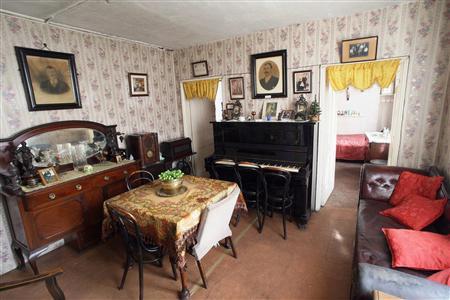
A SLICE OF LIVING HISTORY Hidden in a red brick tenement in the city's historic Bull Alley district, Number 3B, Iveagh Buildings, remains exactly as it was a century ago when Irish philanthropist and brewing magnate Edward Cecil Guinness made quality housing a reality for many of Dublin's poor. Suspended in time, as though its occupant had just stepped out to buy a newspaper, the tiny three room apartment with its creaking furniture and dusty knick knacks, allows a fascinating glimpse into an era that is fast fading from view in a rapidly changing Ireland. Number 3B was preserved as a museum piece in 2002 after the death at the age of 95 of its last tenant, Nellie Molloy, who had lived there all her life, resisting all offers to bring her flat up to the modern standards enjoyed by her neighbors. "Nellie lived with her mother, looking after her until she died in 1967 and after that she just wanted to keep it as it was in her mother's day," said Gene Clayton, chief executive of the Iveagh Trust, set up in 1890 by the then head of the Guinness brewing empire to provide housing for the working poor. "When Nellie died we decided not to refurbish because the flat's the last of its type, and we arranged to buy the contents from her relatives," Clayton said. Those contents include a Singer treadle sewing machine, a scuffed leather sofa, a small coal burning range and a German made Goetze piano in surprisingly good tune. Vying for wall space with copious Roman Catholic iconography are framed family photographs, among them the proud, uniformed figure of Nellie's father, Sgt Major Henry John Molloy of the 5th Leinster Regiment, on leave from World War One. Nearby, a domestic science diploma from 1922 attests to Nellie's home making skills. On a dresser in the bedroom, antique toiletries include "brilliantine" hair gel and a bottle of perfume promising all the romance of an "Evening in Paris". Meals would have been cooked on a small stove in a corner of one of the tiny bedrooms, while bathroom facilities were across the hallway and would have been shared with four other families. While a wall mounted gas mantle harks back to Victorian times, the flat is wired for electricity - Nellie's one concession to progress. The flat, which is not open to the public, may be cramped but it is cozy and given the block's central location and rents of between 40 and 85 euros ($52-$110) a week compared to a Dublin average of 300 euros ($388) a week, it is not difficult to see why tenants tend to settle for the long term. 'GUINNESS IS GOOD FOR YOU' The Iveagh Buildings, one of the finest examples of Edwardian architecture in Dublin, was just one of the amenities financed by Guinness, who floated the "black beer" business started by his older brother Arthur on the stock market in 1886 and retired, the richest man in Ireland, aged 40. Guinness, who became the first Lord Iveagh in 1891, quickly set about putting chunks of his vast fortune to charitable use. Along with 1,200 apartments, he also provided a 500 room hostel for down on their luck working men, a public bathhouse, a children's play center and sheltered housing for the elderly, most of which are still operational, funded from rental income. In Britain around the same time, Guinness built nearly 30,000 flats for the working poor, most of them in the capital. Having returned to Dublin three years ago from a career in social housing in London, Clayton says his aim is to upgrade the older Iveagh Trust building stock so it will last another century. But he retains a particular affection for Number 3B: "It will remain as it is as long as we're around, because really the longer it exists the more important it becomes."



